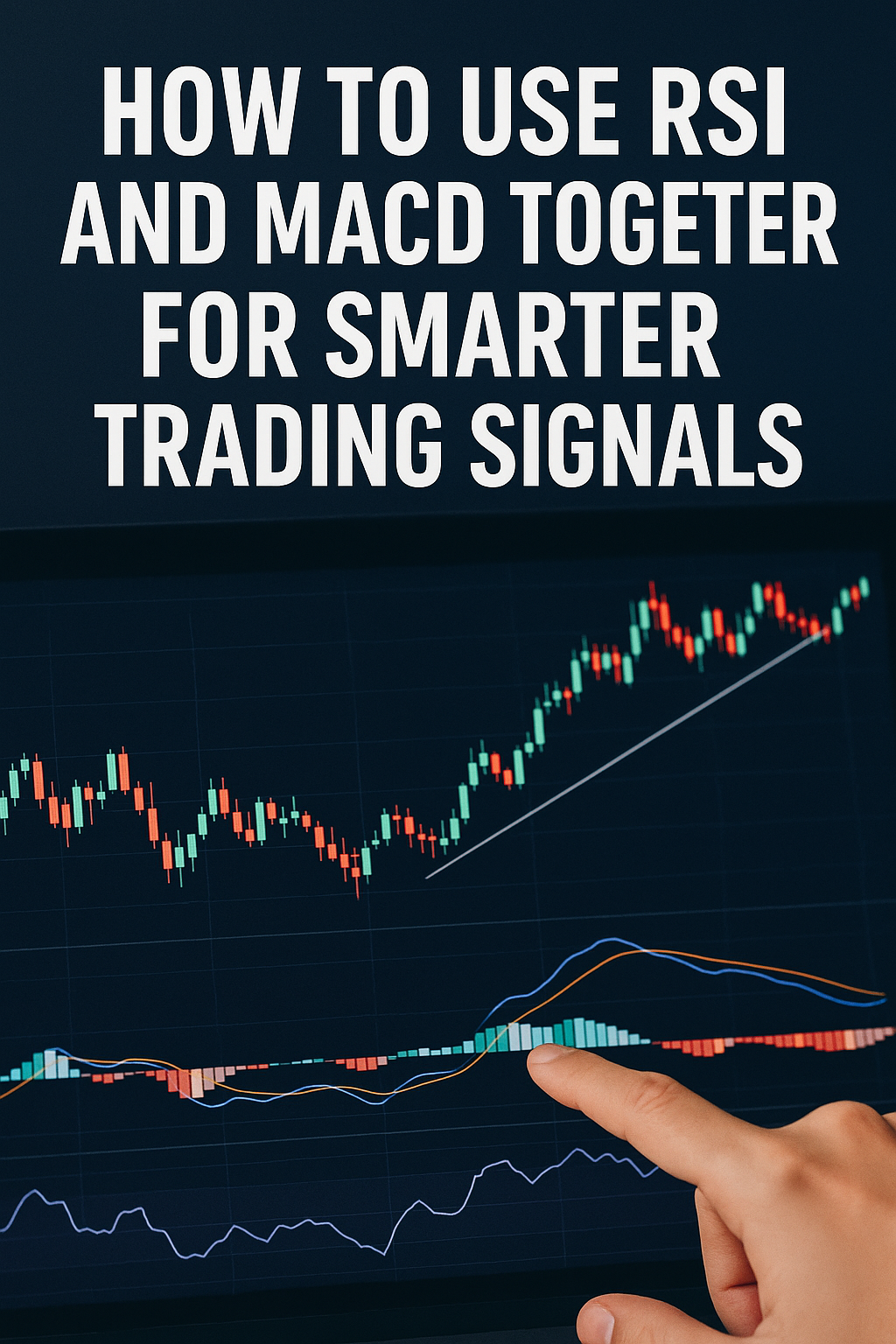Technical indicators are essential tools for traders seeking to navigate the complexities of financial markets, from stocks and forex to cryptocurrencies and commodities. Among the most popular indicators are the Relative Strength Index (RSI) and the Moving Average Convergence Divergence (MACD), each offering unique insights into market momentum and trends. When used together, RSI and MACD can complement each other, providing smarter, more reliable trading signals. This 4,000-word guide explains how to combine RSI and MACD effectively, offering step-by-step strategies, practical examples, and tips to enhance your trading decisions.
Whether you’re a beginner learning technical analysis or an experienced trader refining your strategy, this article will help you harness the power of RSI and MACD on platforms like TradingView. We’ll cover their mechanics, synergy, trading setups, and common pitfalls, ensuring you can apply these indicators with confidence.
Understanding RSI and MACD
What Is the Relative Strength Index (RSI)?
The RSI, developed by J. Welles Wilder, is a momentum oscillator that measures the speed and change of price movements. It ranges from 0 to 100 and helps identify overbought or oversold conditions.
- Calculation: RSI = 100 – [100 / (1 + RS)], where RS (Relative Strength) = Average Gain ÷ Average Loss over a specified period (typically 14).
- Key Levels:
- Above 70: Overbought (potential sell signal).
- Below 30: Oversold (potential buy signal).
- Uses: Identifies reversals, momentum strength, and divergences.
Example: If a stock’s RSI rises above 70, it may indicate overbought conditions, suggesting a potential price pullback. However, in strong trends, RSI can remain overbought for extended periods.
What Is the Moving Average Convergence Divergence (MACD)?
The MACD, developed by Gerald Appel, is a trend-following and momentum indicator that shows the relationship between two exponential moving averages (EMAs) of a security’s price.
- Components:
- MACD Line: 12-period EMA minus 26-period EMA.
- Signal Line: 9-period EMA of the MACD Line.
- Histogram: Difference between MACD Line and Signal Line.
- Key Signals:
- Bullish Crossover: MACD Line crosses above Signal Line (buy signal).
- Bearish Crossover: MACD Line crosses below Signal Line (sell signal).
- Divergence: Price and MACD move in opposite directions, signaling potential reversals.
- Uses: Identifies trend direction, momentum, and reversal points.
Example: A bullish MACD crossover (MACD Line above Signal Line) in an uptrend suggests strengthening momentum, encouraging traders to buy.
Why Combine RSI and MACD?
RSI and MACD complement each other because:
- RSI focuses on momentum and overbought/oversold conditions, ideal for spotting reversals.
- MACD tracks trend direction and momentum shifts, perfect for confirming trends.
- Synergy: RSI filters false MACD signals, while MACD confirms RSI’s momentum signals.
By combining them, traders can reduce noise, improve signal accuracy, and make informed decisions across various markets and timeframes.
Reference Link
Learn more about RSI and MACD from Investopedia’s technical analysis guide.
Step 1: Setting Up RSI and MACD on TradingView
Choosing a Trading Platform
TradingView is a popular platform for technical analysis, offering customizable charts, indicators, and community-driven scripts. It’s ideal for applying RSI and MACD due to its user-friendly interface and robust features.
Adding RSI to Your Chart
- Open TradingView: Sign up or log in at TradingView.com.
- Select an Asset: Choose a stock, forex pair, or crypto (e.g., AAPL, EUR/USD, BTC/USD).
- Add RSI:
- Click “Indicators” at the top of the chart.
- Search for “Relative Strength Index” and add it.
- Default setting: 14-period RSI with 70 (overbought) and 30 (oversold) levels.
- Customize Settings:
- For intraday trading, consider a 7-period RSI for faster signals.
- For swing trading, use a 21-period RSI for smoother signals.
Adding MACD to Your Chart
- Add MACD:
- In the “Indicators” menu, search for “MACD” and add it.
- Default settings: 12, 26, 9 (fast EMA, slow EMA, signal line).
- Customize Settings:
- For short-term trading, try 5, 13, 9 for quicker signals.
- For long-term trading, use 21, 50, 9 for trend confirmation.
- Adjust Visibility: Place MACD below the price chart and RSI in a separate panel for clarity.
Optimizing Your Chart
- Timeframe: Choose a timeframe that matches your trading style (e.g., 5-minute for day trading, daily for swing trading).
- Clean Layout: Avoid clutter by limiting indicators to RSI, MACD, and key price levels (support/resistance).
- Save Template: Use TradingView’s “Save Chart Layout” to reuse your setup.
Reference Link
Explore TradingView’s indicator setup guide at TradingView Support.
Step 2: Understanding RSI and MACD Signals
RSI Signals
- Overbought/Oversold:
- RSI > 70: Potential sell signal, but confirm with price action or MACD.
- RSI < 30: Potential buy signal, especially in oversold markets.
- Divergence:
- Bullish Divergence: Price makes lower lows, but RSI makes higher lows (buy signal).
- Bearish Divergence: Price makes higher highs, but RSI makes lower highs (sell signal).
- Centerline Crossover:
- RSI crossing above 50 indicates bullish momentum.
- RSI crossing below 50 suggests bearish momentum.
Example: On a daily chart of Tesla (TSLA), an RSI below 30 combined with a bullish divergence might signal a buying opportunity if confirmed by other indicators.
MACD Signals
- Line Crossovers:
- Bullish: MACD Line crosses above Signal Line.
- Bearish: MACD Line crosses below Signal Line.
- Zero Line Cross:
- MACD Line crossing above zero indicates a bullish trend.
- MACD Line crossing below zero suggests a bearish trend.
- Histogram:
- Growing positive histogram bars signal increasing bullish momentum.
- Growing negative bars indicate strengthening bearish momentum.
- Divergence:
- Bullish: Price makes lower lows, but MACD makes higher lows.
- Bearish: Price makes higher highs, but MACD makes lower highs.
Example: On a 4-hour EUR/USD chart, a bullish MACD crossover above the zero line might confirm an uptrend, prompting a buy trade.
Combining Signals
RSI and MACD work best when their signals align:
- Bullish Setup: RSI below 30 (oversold) + MACD bullish crossover.
- Bearish Setup: RSI above 70 (overbought) + MACD bearish crossover.
- Divergence Confirmation: Bullish RSI divergence + bullish MACD divergence signals a stronger reversal.
Reference Link
Understand divergences at BabyPips’ technical analysis course.
Step 3: Developing a Trading Strategy with RSI and MACD
Strategy 1: Trend Confirmation
Use MACD to identify the trend and RSI to confirm entry points.
- Identify Trend with MACD:
- Bullish trend: MACD Line above Signal Line and zero line.
- Bearish trend: MACD Line below Signal Line and zero line.
- Confirm with RSI:
- In a bullish trend, wait for RSI to dip below 50 and recover (buy signal).
- In a bearish trend, wait for RSI to rise above 50 and retreat (sell signal).
- Entry:
- Buy when RSI confirms bullish momentum in a MACD-confirmed uptrend.
- Sell when RSI confirms bearish momentum in a MACD-confirmed downtrend.
- Exit:
- Exit longs when RSI approaches 70 or MACD shows a bearish crossover.
- Exit shorts when RSI nears 30 or MACD shows a bullish crossover.
Example: On a daily chart of Microsoft (MSFT), a bullish MACD crossover above zero confirms an uptrend. When RSI dips to 45 and rises above 50, enter a long position. Exit when RSI hits 70.
Strategy 2: Reversal Trading
Use RSI for reversal signals and MACD to confirm momentum shifts.
- Spot Reversals with RSI:
- Look for RSI divergences (bullish or bearish).
- Confirm with RSI crossing the centerline (50).
- Confirm with MACD:
- Bullish reversal: MACD Line crosses above Signal Line or shows bullish divergence.
- Bearish reversal: MACD Line crosses below Signal Line or shows bearish divergence.
- Entry:
- Buy on bullish RSI divergence + MACD bullish crossover.
- Sell on bearish RSI divergence + MACD bearish crossover.
- Exit:
- Use trailing stops or exit when RSI reaches extreme levels (70 or 30).
Example: On a 1-hour Bitcoin (BTC/USD) chart, a bullish RSI divergence (higher lows in RSI, lower lows in price) combined with a MACD crossover above the Signal Line signals a reversal. Enter a long position and exit when RSI hits 70.
Strategy 3: Pullback Trading
Use RSI to time pullbacks in a MACD-confirmed trend.
- Confirm Trend with MACD:
- Bullish: MACD Line above Signal Line and zero line.
- Bearish: MACD Line below Signal Line and zero line.
- Identify Pullbacks with RSI:
- In an uptrend, wait for RSI to drop to 40–50 (pullback).
- In a downtrend, wait for RSI to rise to 50–60 (pullback).
- Entry:
- Buy when RSI recovers from a pullback in an uptrend.
- Sell when RSI retreats from a pullback in a downtrend.
- Exit:
- Exit longs when RSI hits 70 or MACD signals weakening momentum.
- Exit shorts when RSI hits 30 or MACD signals a trend shift.
Example: On a 4-hour SPY (S&P 500 ETF) chart, a bullish MACD trend is confirmed. When RSI drops to 45 during a pullback and rises above 50, enter a long position. Exit when RSI reaches 70.
Reference Link
Learn trend-following strategies at StockCharts’ technical analysis guide.
Step 4: Backtesting Your RSI and MACD Strategy
Why Backtesting Matters
Backtesting involves testing your strategy on historical data to evaluate its performance. TradingView’s Strategy Tester makes this process accessible for beginners.
How to Backtest on TradingView
- Create a Strategy:
- Use TradingView’s Pine Script Editor to code your RSI and MACD rules (or find community scripts).
- Example: Buy when RSI < 30 and MACD Line > Signal Line; sell when RSI > 70.
- Run the Strategy Tester:
- Go to the “Strategy Tester” tab.
- Select your asset, timeframe, and date range.
- Analyze metrics like win rate, profit factor, and drawdown.
- Optimize Settings:
- Test different RSI periods (e.g., 7 vs. 14) and MACD settings (e.g., 5,13,9 vs. 12,26,9).
- Adjust stop-loss and take-profit levels.
Example Backtest
A trader backtests a trend confirmation strategy on the 1-hour EUR/USD chart:
- Rules: Buy when MACD Line > Signal Line and RSI > 50; sell when MACD Line < Signal Line and RSI < 50.
- Results: 60% win rate, 1.5 profit factor over 6 months.
- Optimization: Switching to a 7-period RSI improves the win rate to 65%.
Reference Link
Master backtesting with TradingView’s Strategy Tester guide.
Step 5: Managing Risks and Avoiding Pitfalls
Common Pitfalls
- Over-Reliance on Indicators:
- RSI and MACD are not foolproof; they can produce false signals in choppy markets.
- Solution: Combine with price action (e.g., support/resistance, candlestick patterns).
- Ignoring Market Context:
- RSI overbought signals in strong uptrends may not lead to reversals.
- Solution: Use MACD to confirm trend strength and check TradingView’s Economic Calendar.
- Overtrading:
- Frequent trades based on every signal increase transaction costs.
- Solution: Focus on high-probability setups with clear confirmations.
- Improper Settings:
- Default settings may not suit your timeframe or asset.
- Solution: Test custom settings (e.g., 7-period RSI for intraday).
Risk Management Techniques
- Position Sizing: Risk no more than 1–2% of your account per trade.
- Stop-Loss Orders: Place stops below support (for longs) or above resistance (for shorts).
- Take-Profit Levels: Set targets based on risk-reward ratios (e.g., 2:1).
- Diversification: Trade multiple assets to spread risk.
- Journaling: Track trades on TradingView to identify patterns and improve.
Example
A trader risks $100 on a $5,000 account (2%) trading AAPL. They buy at $150 with a stop-loss at $145 and a take-profit at $160, aiming for a 2:1 risk-reward ratio. RSI and MACD confirm the setup, reducing the likelihood of a false signal.
Step 6: Advanced Tips for RSI and MACD
Customizing Indicator Settings
- RSI:
- Short-term: 7-period RSI for faster signals.
- Long-term: 21-period RSI for smoother signals.
- Adjust overbought/oversold levels (e.g., 80/20 for trending markets).
- MACD:
- Fast settings (5,13,9) for intraday trading.
- Slow settings (21,50,9) for swing trading.
- Use a shorter signal line (e.g., 5) for quicker exits.
Combining with Other Indicators
- Moving Averages: Confirm trends with 50-day or 200-day EMAs.
- Bollinger Bands: Use RSI for overbought/oversold signals within Bollinger Band ranges.
- Volume: Confirm MACD crossovers with rising volume for stronger signals.
Using AI for Optimization
Prompt ChatGPT with:
“Suggest RSI and MACD settings for day trading forex on a 15-minute chart.”
A sample response might include:
- RSI: 7-period, overbought at 75, oversold at 25.
- MACD: 5,13,5 for faster signals.
- Combine with 20-period EMA for trend confirmation.
Reference Link
Explore advanced technical analysis at TradingView’s Pine Script documentation.
Conclusion
Combining RSI and MACD creates a powerful framework for smarter trading signals, blending momentum and trend analysis to improve decision-making. By setting up these indicators on TradingView, understanding their signals, developing strategies, backtesting, and managing risks, traders can enhance their performance across various markets. Whether you’re trend-following, reversal trading, or timing pullbacks, RSI and MACD offer versatile tools to navigate price action with confidence.
Start experimenting with RSI and MACD today, leveraging TradingView’s features and AI-driven insights to refine your approach. With practice and discipline, you’ll turn these indicators into valuable allies for your trading journey.
Disclaimer
The information provided in this article is for educational purposes only and does not constitute financial advice. Trading involves significant risks, including the potential loss of capital. Always conduct your own research and consult a qualified financial advisor before making trading decisions. The author and publisher are not responsible for any losses incurred from using the information in this article.








